Purebred Dingoes are not your average dog

Purebred Dingoes are not your average dog
According to scientific research, pure desert dingoes are not the same as domestic dogs because of the environments they have evolved in.
Dingoes live in Australia and it has been revealed that their genetics are a mix between wolves and domesticated dogs. In this blog, we dive into why purebred dingoes are not your average dog.
What this means
A team of researchers studied Sandy Maliki, a pure desert dingo whose genome was fully decoded.
She was discovered with her brother and sister at just three weeks old in the central Australian desert. After winning ‘world’s most interesting genome’ in 2017, funds were awarded to researchers to conduct the DNA sequencing.
Sandy’s genome was compared to five domestic dogs including a basenji, a boxer, a labrador retriever, a German shepherd, a great dane and a Greenland wolf.
Through DNA sequencing and epigenetic analysis, distinct differences between dingoes and domestic dog breeds were revealed.
Firstly, dingoes are similar to wolves when it comes to amylase genes – an enzyme that helps digest starches. They only have one copy of it.
“Breed dogs, which only emerged in the last 200 years, have between two and 20 copies of this gene,” explained Matt Field, an associate professor at James Cook University and the study’s first author.
“That’s one of the telltale signs of domestication and [in dingoes] it’s not there.”
Professor Bill Ballard, the study senior author from La Trobe University says this is the case because when dogs were first becoming domesticated, humans were feeding them things with lots of starch, like rice.
“Those dogs that did better with the rice were … more likely to be associated with humans over time,” he said.
This could result in problems with conservation efforts.
“If a pure dingo eats very different things to a wild dog, then it’s going to have a different position in the ecosystem and … be differentially attracted to different foods.”
When analyzing German shepherd and dingo scat, the German shepherd had high concentrations of three different bacteria related to breaking down starchy ingredients.
These microbiome differences could be why we aren’t seeing feral dogs in Australia.
Dingoes and history
“[Dingoes] are older than the oldest domestic dog breed, which is the basenji. Their results clearly demonstrated that,” said Dr. Kylie Cairns of the University of New South Wales. “Dingoes are a wild canid that has been shaped by Australia’s climate and ecology over thousands of years.”
“The implications of that are that they should be treated like wildlife. The dingo is the only native animal that is baited and killed across national parks and conservation reserves in Australia.”
“We need to respect their place as the apex predator in Australia, because they have an important ecological role,” she added. “We need to figure out a better way of coexisting with them so that we can have agriculture of livestock – particularly sheep – but that we continue to have dingoes in the environment.”
Next, the scientists are going to focus on whether or not the dingo has ever been domesticated. They will also be studying the DNA from the alpine dingo and the Fraser Island dingo. This is to better understand dingo crossbreeding and what impacts it has on their behaviours and how they contribute to the ecosystem.






